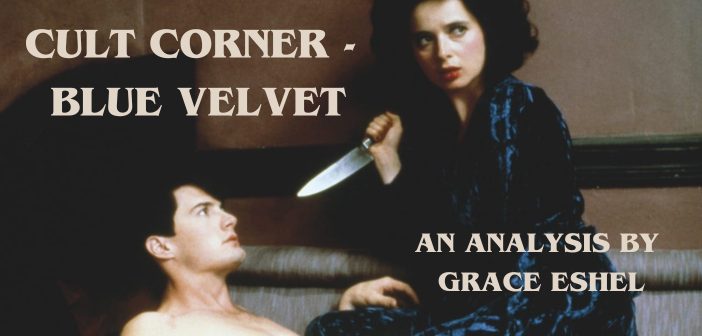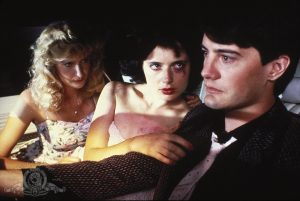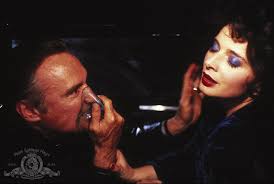‘Blue Velvet’ literally means an illicit opioid concoction taken by injection. That is exactly what David Lynch creates in this 1986 cult classic. Lynch goes beneath the skin of suburbia, driving a needle into a nightmarish, seedy underbelly. He is known for his exploration of the darker sides of life through surrealism and in Blue Velvet, he masterfully and artistically opens the viewer’s eyes to the shadowy corners of life, the parts everyone knows occur, but seemingly no one partakes in – least of all an upstanding suburban citizen, guarded by a white picket fence.
The plot begins with Jeffrey (Kyle MacLachlan) finding a severed ear and from there the story spirals. It twists from a classic small-town criminal investigation to an exploration of sexual violence, sadomasochism, and, in my reading of the film, the duality of both American idealism and human nature. These themes are not simply represented within the film. They are the very fabric of the film. Every creative and technical choice made by Lynch had these themes at the forefront. Take, for example, Jeffrey’s earring. The choice to have the walking archetype of the all-American-boy sport a small single silver hoop unlocks the entirety of his character. He is a suburban dream, he has a steady job, cares for his family, and is classically good-looking. But, the small hoop is a constant reminder that even inside a perfect citizen, there is more than meets the eye. Piercings have been branded by conservatives as a form of rebellion and unprofessionalism in Western culture for decades. So, the choice to give the American hero of the story a small hoop on his left ear, symbolises Jeffrey’s openness to another side of life, a rebellious and lawless side. He naturally gets far more than he bargains for, but the concept that he was even open to new ideas is subtly there from the very beginning.
This film uses morbid curiosity in its favour, both the morbid curiosity of the characters and the audience. When Jeffrey breaks into Dorthoy’s house, the audience is represented in Sandy, who is anxiously waiting for him outside. She must have some kind of morbid, twisted fascination with the dark side of her North Carolina town to even be there in the first place, the same way we as the audience are watching the film because we are morbidly curious about this supposedly controversial cult classic.
There is a sense of voyeurism that permeates the film and our consumption of it. The initial break-in scene is a perfect representation of all of the characters, and it situates the audience in a position of confusion and curiosity. It raises the question of who to root for when lines of morality become blurred. The perfect, all-American dream girl Sandy is put in direct contrast with Dorothy, the exploited and abused shell of her former self. Sandy is everything Dorothy could have been had Frank not targeted her, and Dorothy represents how very easy it is to fall through the cracks of society. The bridge between them is Jeffrey, curious and protected by the fact he is largely socially secure.
Now, it would be far too easy to dissect Blue Velvet scene by scene, digging through details like some surgeon with far too much time on her hands, so in the interest of retaining readership, we move to the surreal sequences that Lynch is known for, and look at the sex scenes between Jeffrey and Dorothy. They are eerie and dreamlike, but Lynch has a way of shooting them that doesn’t just feel like voyeurism in the nasty, perverted sense. Instead, there is a palpable tension and mystery surrounding them. The scenes are necessary for the plot and constructed in such a way that it intrigues the viewer. Sucking them into this mystical dreamscape that exists within the depths of the typical suburban setting – fuelling the idea that anything could be happening next door and you may never know. The sadomasochism present in the relationship is also well-done, it again does not feel perverted or romanticised. It is clear Dorothy’s desires have been shaped by her trauma, and Lynch makes it clear that Jeffrey is not simply beating her in the same way Frank does. It is complicated and layered and these scenes work well to juxtapose the sequences of brutal assaults Frank commits throughout the film.
In fact, Frank’s assaults also work as part of the social commentary. He is exploiting Dorothy, he is exploiting the power he wields as a white man in suburbia, he exploits everything at his disposal and this can be read as an exploitation of the American Dream – this is the idea that if you work hard, you can ‘make it’. Frank works at the expense of others, he has it made for himself in an incredibly destructive and violent way, using fear to control those around him.
Of course, this is a Cult Corner pick, meaning at the time of release it did not gain the traction or critical acclaim it has today, it had a small, dedicated following, but was widely criticised for its controversial choice to show on-screen sexual violence. However, Blue Velvet has since been recognised and praised for its willingness to delve into these topics. It has only aged so well because the violence portrayed is not gratuitous. It is deeply disturbing and uncomfortable to watch – with the character of Frank Booth being one of the most disgusting characters ever put to screen – but at no point does it feel Lynch is creating these scenes in a malicious, or misogynistic way. The scenes are necessary for his story, and at no point feel like fantasy fulfilment.
Ultimately, Blue Velvet has held up as a dreamy nightmare of a social commentary and is alarmingly relevant to this day. Lynch’s exploration of what goes on behind closed doors will forever be one of my personal favourites of his, hence why it is this month’s Cult Corner pick!







